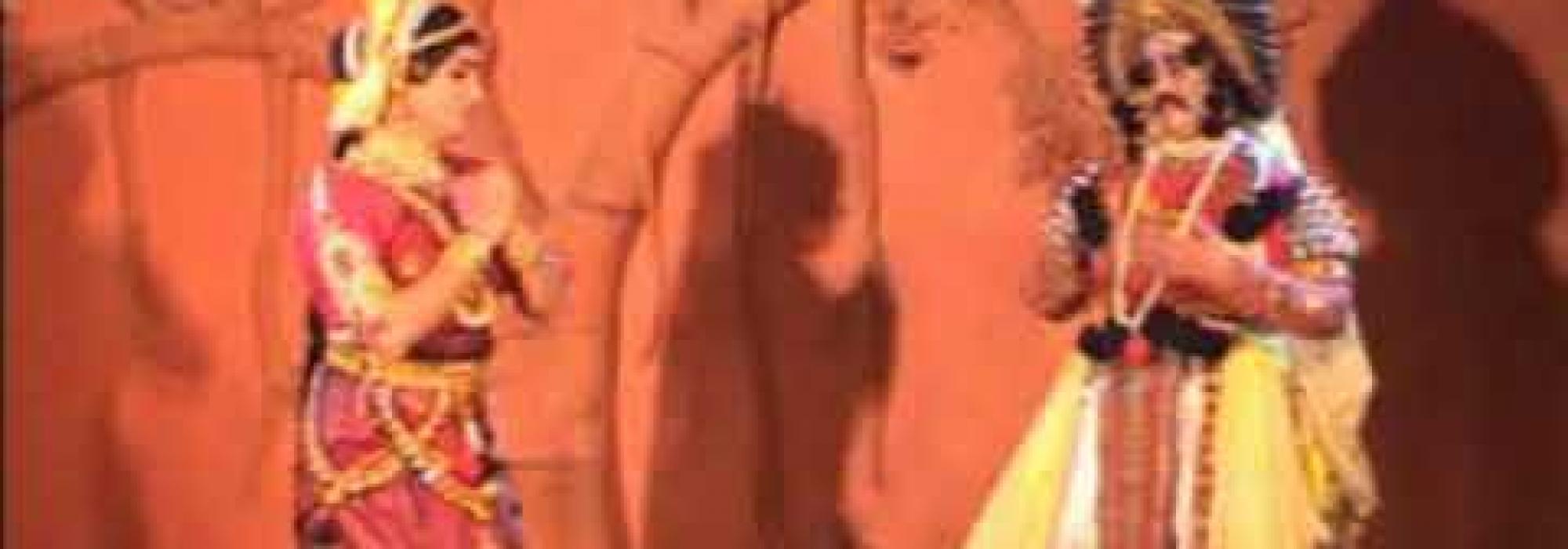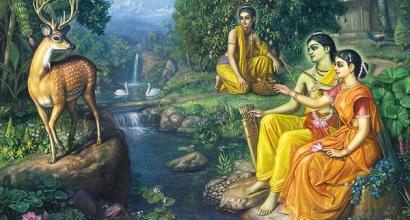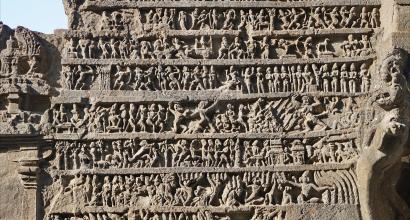We have hitherto discussed about āhārya, āṅgika, and vācika. The next aspect to discuss is sāttvikābhinaya – the most difficult aspect to teach and to express in words. In another sense, it is also easy to speak about sāttvikābhinaya because every form of expression finally culminates in sāttvika. It is only through sāttvika that śānta comes as the backdrop for all bhāvas and elevates them to the level of Rasa. And yet, how can we point to an exclusive thing called space? It is all-pervading and ever-existing. We can only figuratively establish the presence of sāttvika; we cannot literally show its existence. For an art to evoke sāttvika, one has to tread the dhvani-mārga (path of suggestion) and śāstra has to resort to the same path in its attempt to delineate sāttvika.
As mentioned earlier, our Ekavyakti-yakṣagāna presentation was born because of the affinity that both Mantap and I have for sāttvikābhinaya. Some scholars and connoisseurs raised objections about the āṅgika, āhārya, and vācika used by Mantap. However, no scholar or connoisseur expressed any doubts or reservations regarding the effectiveness of his sāttvikābhinaya. His sāttvika is clear, intense, original and sublime. Kampa, sveda, aśru, vaivarṇya, romāñca, stambha, svarabheda, and all other sāttvika-bhāvas come to him effortlessly.
The renowned danseuse Smt. Sundari Santhanam, known for her objective outlook, honest review and critical observations once remarked, “There are only two artistes who have reached the peaks of sāttvikābhinaya – one is my teacher Padma Bhushan Dr. Padma Subrahmanyam and the other is my student Sri Mantap Prabhakar Upadhya.”
Sāttvikābhinaya is rooted in sattva. Abhinava-gupta defines it as ‘cittaikāgryaṃ’ (Abhinava-bhāratī), Hemacandra calls it ‘prāṇātmakaṃ vastu’ (Kāvyānuśāsana, vṛtti on 2.53) and Viśvanātha identifies it as ‘svātmaviśrāma-prakāśakārī kaścana āntaro dharmaḥ’ (Sāhityadarpaṇa, vṛtti on 3.134). Bharata has defined it as ‘Manasas-samādhau sattva-niṣpattir-bhavati’ (Nāṭyaśāśtra 7.147). It is only with intense concentration and mental tranquility that an artiste can perform sāttvikābhinaya – it is nothing but the pouring out of the antarātma-prakāśa, i.e., the light and delight of the inner landscape. This kind of abhinaya is the equivalent of pratyakṣīkaraṇa-māhātmya (the glory of emotionally actualizing a situation) in the concept of bhāvika[1] as defined by the poeticians.
Sāttvika needs to pervade all dimensions of the presentation. It can, in fact, inspire several creative ideas and can string together different imageries effectively on the stage. I have always been mesmerized by the impact that sāttvika can have.
Before staging a production, I narrate the story in detail to Mantap. I also explain the lyrics of songs. I suggest the kind of abhinaya he can fill in at different places (and sometimes enact them too, within my limited capacity). Once Mantap goes on the stage, however, inspired by the ensemble music, he creates such great imageries spontaneously that it takes me by surprise. Most of the times it is totally different from what we would have earlier discussed and neither of us would have conceived the kind of ideas he conjures up on the stage. These have always captured the hearts of the audience and given them a glimpse of sublimity. Mantap’s interpretations are never repetitive. Every presentation is novel, fresh, and original. Most of the times he creatively makes use of the available stage properties, the particular dais and the location. In the early days of our presentations, I would request Mantap to remember everything he enacted and to repeat the same in the following shows. I later realised that by doing so we would be limiting the potential of impromptu abhinaya and this sort of manodharma is the real hallmark of a talented artiste. Creative ideas that have occurred spontaneously cannot be memorized and repeated and even when done so, they will only appear artificial. I decided that aucitya should be the only governing parameter for abhinaya.
Many dancers, spellbound by Mantap’s abhinaya, have come to him seeking guidance. Dancers belonging to all different froms of dance have been carried away by his sāttvikābhinaya and have been particularly astonished when they discovered that all this was apūrva-siddha – without prior preparation. They have incorporated his suggestions and lessons in their art. Mantap’s strengths are in elaboration of details through subtle loka-dharmī and in delineating the emotional landscape of the characters he chooses to enact. There is no distinction between nṛtta and sāttvikābhinaya in his presentations. At times, what was pre-decided to be a minute-long abhinaya segment would have been elongated into a detailed abhinaya lasting thirty minutes. That said, we have strictly adhered to time in all our presentations. We cropped unnecessary segments and limited the abhinaya to the needs of the production.
There are many instances where Mantap’s sāttvikābhinaya has reigned supreme. The characters of vāsakasajjikā and svādhīnapatikā in Bhāminī, Yaśodhā, Rukmiṇī, and Draupadī in Śrī-kṛṣṇārpaṇa are worth observing. His elaboration of the line raṅganyātakè bāranè (Why doesn’t my Raṅga come?) in Yakṣa-darpaṇa is filled with tremendous detail. Rādhā of Veṇu-visarjana, Sītā of Jānakī-jīvana, Viṣayè of Yakṣa-kadamba, and the characters Pūtanā, śūrpaṇakhā, and Dākṣāyanī have always been creatively presented by Mantap. In fact, it would be better to say that all his presentations are rich in sāttvikābhinaya. Here only a couple of examples are described due to paucity of space:
Mantap enacts the vāsakasajjikā’s dreams and fantasies as she draws the raṅgavallī. He beautifully portrays the feeling of emptiness and dejection of a proṣitapatikā as she sweeps the front yard of her house. His depiction of a vāsakasajjikā who prepares for her husband’s arrival is original and new – the vāsakasajjikā does not wear ornaments as her beloved is away; the mirror in her house has accumulated, suggesting her disinterestedness in any kind of embellishments. She combs her hair, wears her earrings, and puts on a mark of kuṅkuma on her forehead. Mantap even enacts the manner in which the kuṅkuma falls on to her nose from her forehead and the vāsakasajjikā removes it with her index finger. Mantap provides different interpretations for the line ènnavanèm cannano (‘how charming is my beloved!’) and the tens of ideas that pour out from him can even work as the governing rules for the life of a couple today. He shows the difficulties and pleasures of married life and the romance of a newly married couple. His abhinaya also includes the manner in which a married woman metamorphoses into a mother. He depicts the manner in which a pregnant woman may inform her husband of her conception.
In the production Śrī-kṛṣṇārpaṇa, Mantap enacts the role of Yaśodhā, bringing in many varieties of moods. Yaśodhā removes her bangles and anklets to create an ambience of silence so that the baby sleeps. She teaches him to play the flute and is proud that she is the guru of the Jagadguru (Kṛṣṇa is called Jagadguru – teacher of the entire world). The manner in which Rukmiṇī writes a letter that is filled with her feelings of love for Kṛṣṇa is a great contrast to the manner in which Mantap presents Viṣayè who reads out the letter Candrahāsa carries. The sublime silence of Rukmiṇī, as she sees her beloved Kṛṣṇa, who has come to pick her up is something which words cannot capture. Similar is the pain that Sītā experiences upon seeing an emaciated Rāma, just before she enters the Mother Earth – before leaving him forever, she feels sorry for Rāma who looks weak.
To be continued...
This series of articles are authored by Shatavadhani Dr. R Ganesh and have been rendered into English with additional material and footnotes by Arjun Bharadwaj. The article first appeared in the anthology Prekṣaṇīyaṃ, published by the Prekshaa Pratishtana in Feburary 2020.
[1] भाविकत्वमिति प्राहुः प्रबन्धविषयं गुणम्।
प्रत्यक्षा इव दृश्यन्ते यत्रार्था भूतभाविनः (Bhāmaha’s ‘Kāvyālaṅkāra’ 3.53)
तद्भाविकमिति प्राहुः प्रबन्धविषयं गुणम् ।
भावः कवेरभिप्रायः काव्येष्वासिद्धिसंस्थितः॥
परस्परोपकारित्वं सर्वेषां वस्तुपर्वणाम् ।
विशेषणानां व्यर्थानामक्रिया स्थानवर्णना॥
व्यक्तिरुक्तिक्रमबलाद्गभीरस्यापि वस्तुनः।
भावायत्तमिदं सर्वमिति तद्भाविकं विदुः॥ (Daṇḍi’s Kāvyādarśa 2.364-366)














































